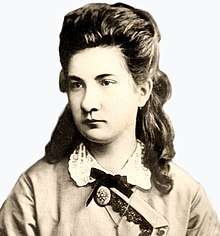Maria Pavlova
Maria Vasilievna Pavlova[lower-alpha 1] (Russian: Мария Васильевна Павлова; née Gortynskaia (Гортынская); June 26, 1854 – December 23, 1938) was a Russian paleontologist, known for her research of fossil hoofed-mammals and efforts to establish the Museum of Paleontology at Moscow State University.
Maria V. Pavlova | |
|---|---|
 | |
| Born | June 26, 1854 |
| Died | December 23, 1938 (aged 84) |
| Alma mater | University of Paris |
| Scientific career | |
| Fields | Paleontology |
Early life
Maria Vasillievna Gortynskaia was born in Kozelets, Ukraine in 1854. She was schooled at home until 1865, and was thereafter educated at the Kiev Institute of Noble Maidens until 1870. After a short marriage, her husband Illich-Shishatskaya died, and she moved to Paris to study in 1880. She studied a number of natural history subjects and pursued research at the National Museum of Natural History under Professor Albert Gaudry in Paris. After graduating from the Sorbonne in 1884 she returned to Russia and married geologist and paleontologist Alexei P. Pavlov, whom she had met in Paris [1][2][3][4].
Career
Pavlova initially studied the geological collections of the museum at Moscow State University, working without payment. She moved from submitting papers on Early Cretaceous ammonites from the Volga region, to pursuing research into Tertiary mammals. She studied their evolution, using data collected from Russia, Western Europe and America. Her work reached an international audience. She studied ungulate mammals and proboscidians. By 1894 she was working on Russian mastodons[4].
In 1897, Pavlova was one of only two women invited to join the Organizing Committee and presentations of the International Geological Congress (IGC) held in St. Petersburg, Russia for the first time. She published Fossil Elephants in 1899. She would go on to describe separate groups of fossil mammals, and complete faunas. Her extensive work in describing and tracing the genetic lines of many large mammals, based on collections in the Palaeontological Museum at Moscow State University, led to the museum being named for her and her husband in 1926, in recognition of their research[4].
Pavlova was made a professor at Moscow State University in 1919[5].
Pavlova went on her last geological expedition in 1931, to the city of Khvalynsk.
Maria Vasilievna Pavlova died on December 23, 1938 in Moscow. She was buried in the Novodevichiy cemetery[4].
Professional memberships
Pavlova was a member of many Russian scientific organizations, including:[4]
- Moscow Society of Naturalists
- Honorary Member of the Mineralogical Society (Honorary member)
- Moscow Society of Amateurs of Natural Sciences, Anthropology and Ethnography
- Russian Geographical Society
- Uralian Society of Amateurs of Natural Sciences
- Novorossiysk Society of Naturalists
- Russian Mining Society
- The Academy of Sciences of the USSR (honorary member)
Notes
- Variant spellings include Marie and Mariia for her given name and Pavlov or Pavlow for her surname by marriage.
References
- Creese, Mary R. S. (2007). "Fossil hunters, a cave explorer and a rock analyst: notes on some early women contributors to geology". In Burek, Cynthia V.; Higgs, Bettie (eds.). The Role of Women in the History of Geology. Geological Society of London. pp. 45–46. ISBN 978-1-86239-227-4.
- Creese, Mary R. S. (2015). Ladies in the Laboratory IV: Imperial Russia's Women in Science, 1800-1900. Rowman & Littlefield Publishers. pp. 99–101. ISBN 978-1-4422-4742-0.
- Marilyn Bailey Ogilvie; Joy Dorothy Harvey (2000). The Biographical Dictionary of Women in Science: L-Z. Taylor & Francis. pp. 992–993. ISBN 978-0-415-92040-7.
- "Natural History Museum Archive Catalogue". www.nhm.ac.uk. Retrieved 2018-04-12.
- Valkova, Olga. "The Conquest of Science: Women and Science in Russia, 1860–1940". Osiris. 23 (1): 136–165. doi:10.1086/591872.